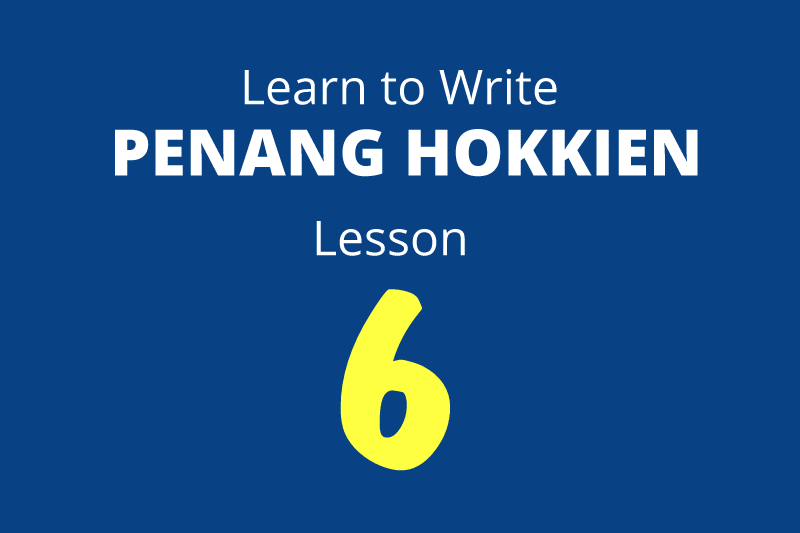
Now that we have gotten the ground rules in place, it's time for us to learn words in Penang Hokkien. You will see that I'm going at one baby step at a time, so that you have a chance to fully get to know the words I introduce in each lesson. Of course you have also learned a few words in the earlier lessons. You have also learned a few terms that I will use regularly, such as "citation form" (the form of a word that you get from the dictionary), "sandhi form" (the form of a word after it undergoes a tone change), and "morpheme" (the basic grammatical unit, which can be as short as one syllable, and carries a meaning). We also learn the "canonical form" (the main form when a word has several variants) and the "alternative form" (optional ways to write/pronounce the same word). Today we learn the personal pronouns "I" and "you".
"I" in Penang Hokkien is wah4
 . Please learn the spelling along with the tone number. This is a canonical form.
. Please learn the spelling along with the tone number. This is a canonical form.Some of us in Penang also pronounce it as gua4
 , so it's good to know the alternative form as well. I read in Wikipedia that the Penang wah4 bears Teochew influence. All right.
, so it's good to know the alternative form as well. I read in Wikipedia that the Penang wah4 bears Teochew influence. All right."You" in Penang Hokkien is lu4
 . There is no other variant that I can think of. Except perhaps, I should point out that it is different from "you" pronounced in the southern part of Peninsula Malaysia. There, they say li4. If you want to be recognised as speaking Penang Hokkien, then learn lu4.
. There is no other variant that I can think of. Except perhaps, I should point out that it is different from "you" pronounced in the southern part of Peninsula Malaysia. There, they say li4. If you want to be recognised as speaking Penang Hokkien, then learn lu4.Now let's put these two into a simple sentence.
I call you.
Wah1 kio33 lu4.

Notice here that "wah4" (citation form) has changed to "wah1" (sandhi form). It's the same if you invert the sentence.
You call me.
Lu1 kio33 wah4.

As you can see, "lu4" (citation form) also changes to "lu1" (sandhi form). You use the citation form when wah4 and lu4 appears as the object, you use the sandhi form when they appear as the subject. The good news is that pronouns in Hokkien don't undergo conjugation (there's no change in spelling, from "I" to "me", it's always wah, wah, wah, only the tone number changes).
Sentences where "wah4" and "lu4" are in the sandhi form are "regular sentences". In Penang Hokkien, you can emphasize specific words in a sentence, and wah4, lu4 are among them. To emphasize means to stress; you do so in English by underlining when you write or type, and in print, it appears as italics. But in Penang Hokkien, you don't need to underline or italicize. You emphasize by changing the tone back to the citation form. Like this:
I call you.
Wah4 kio33 lu4.

In the above example, the subject pronoun wah4 is emphasized, so it reverts to the citation form. The sentence means "I (not Jack, not Mary) call you".
The emphatic form of the subject pronouns wah4 and lu4 appear in colloquial speech more often than would the corresponding in English. When you listen to people speaking Penang Hokkien, you will notice that the speaker often ding-dong between wah1 and wah4 when used as subject, but he will always use wah4 for object. (Similarly, it's gua4 and gua1, if he uses that variant.)
So that covers our lesson for today. In our next lesson, we learn to use "he", "she" and "it".
Previous Lesson | Main Page | Next Lesson
Learn Penang Hokkien with Memrise
Now you can use the most user-friendly tool on the web to learn Penang Hokkien. It helps you to listen, understand and memorise. Go to Memrise, and learn Penang Hokkien at your own pace.
Return to Penang Hokkien Resources
Latest from Discover with Timothy: Gurney Bay - what to see and do there
About this website

Hello and thanks for reading this page. My name is Timothy and my hobby is in describing places so that I can share the information with the general public. My website has become the go to site for a lot of people including students, teachers, journalists, etc. whenever they seek information on places, particularly those in Malaysia and Singapore. I have been doing this since 5 January 2003, for over twenty years already. You can read about me at Discover Timothy. By now I have compiled information on thousands of places, mostly in Peninsular Malaysia and Singapore, and I continue to add more almost every day. My goal is to describe every street in every town in Malaysia and Singapore.
Robbie's Roadmap
- Episode 1: Robbie's Journey to Financial Freedom
- Episode 2: Lost in America
- Episode 3: The Value of Money
- Episode 4: The Mentor
- Episode 5: The Thing that Makes Money
- Episode 6: The walk with a Billionaire
- Episode 7: The Financial Freedom Awakening
- Episode 8: Meet Mr Washington
- Episode 9: The Pizzeria Incident
Copyright © 2003-2024 Timothy Tye. All Rights Reserved.


 Go Back
Go Back